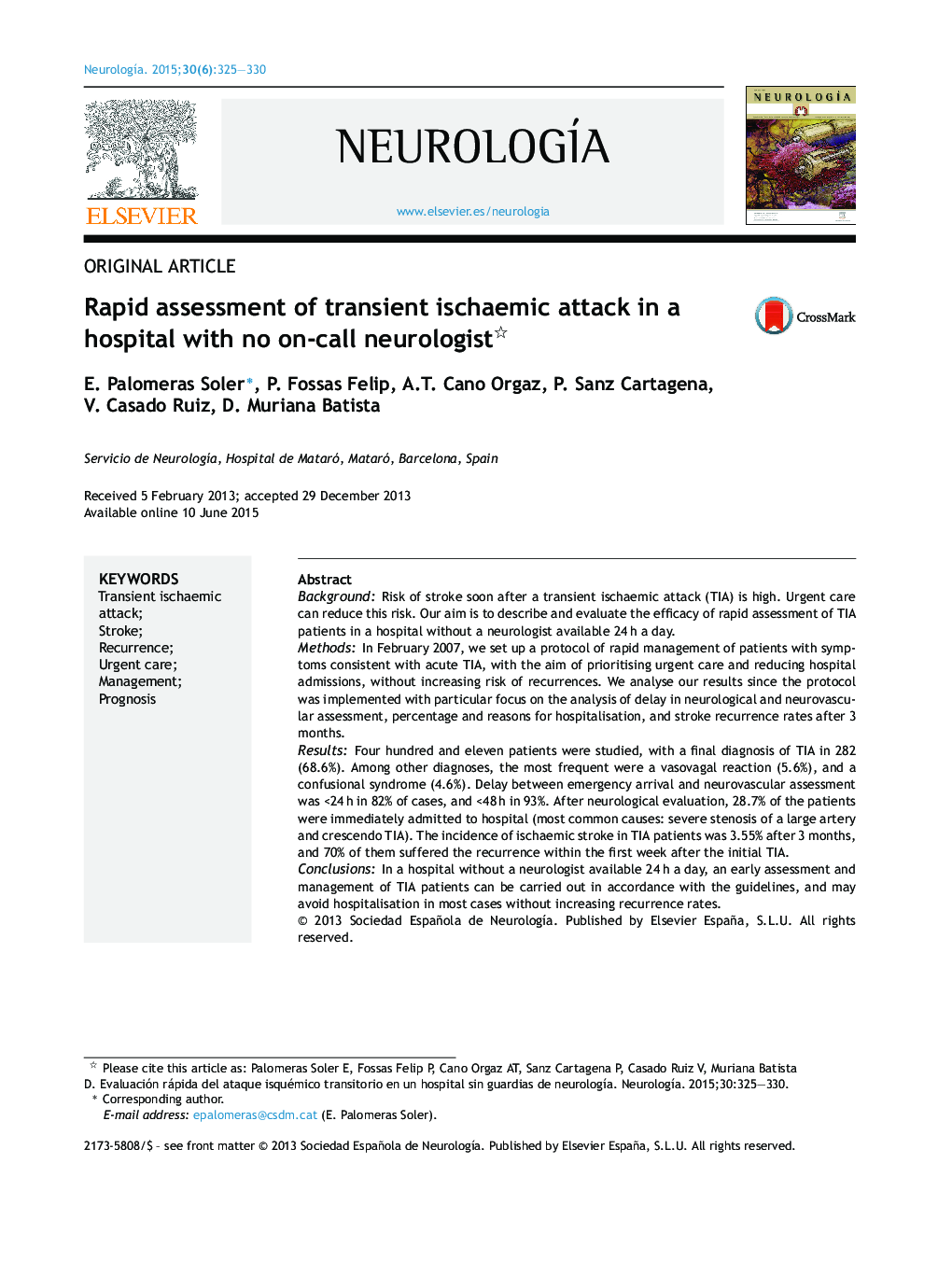| کد مقاله | کد نشریه | سال انتشار | مقاله انگلیسی | نسخه تمام متن |
|---|---|---|---|---|
| 3077243 | 1189130 | 2015 | 6 صفحه PDF | دانلود رایگان |

BackgroundRisk of stroke soon after a transient ischaemic attack (TIA) is high. Urgent care can reduce this risk. Our aim is to describe and evaluate the efficacy of rapid assessment of TIA patients in a hospital without a neurologist available 24 h a day.MethodsIn February 2007, we set up a protocol of rapid management of patients with symptoms consistent with acute TIA, with the aim of prioritising urgent care and reducing hospital admissions, without increasing risk of recurrences. We analyse our results since the protocol was implemented with particular focus on the analysis of delay in neurological and neurovascular assessment, percentage and reasons for hospitalisation, and stroke recurrence rates after 3 months.ResultsFour hundred and eleven patients were studied, with a final diagnosis of TIA in 282 (68.6%). Among other diagnoses, the most frequent were a vasovagal reaction (5.6%), and a confusional syndrome (4.6%). Delay between emergency arrival and neurovascular assessment was <24 h in 82% of cases, and <48 h in 93%. After neurological evaluation, 28.7% of the patients were immediately admitted to hospital (most common causes: severe stenosis of a large artery and crescendo TIA). The incidence of ischaemic stroke in TIA patients was 3.55% after 3 months, and 70% of them suffered the recurrence within the first week after the initial TIA.ConclusionsIn a hospital without a neurologist available 24 h a day, an early assessment and management of TIA patients can be carried out in accordance with the guidelines, and may avoid hospitalisation in most cases without increasing recurrence rates.
ResumenIntroducciónLos pacientes que presentan un ataque isquémico transitorio (AIT) tienen un alto riesgo de tener un ictus a corto plazo. Una atención urgente puede reducir dicho riesgo. El objetivo es describir y comprobar la eficacia de un protocolo de atención rápida a estos pacientes en un hospital sin guardias de neurología.MétodosEn febrero del 2007 se puso en marcha en nuestro hospital un protocolo de evaluación rápida del AIT, con el objetivo de priorizar la atención urgente y disminuir ingresos hospitalarios sin aumentar riesgo de recurrencias. Se analizan los resultados tras los primeros 5 años, incidiendo especialmente en los tiempos de valoración neurológica y neurovascular, motivos de ingreso y tasa de recurrencia a los 90 días.ResultadosHan sido evaluados 411 pacientes, de los cuales 282 (68,6%) fueron finalmente AIT. Entre los otros diagnósticos, los más frecuentes han sido el episodio vasovagal (5,6%) y el cuadro confusional (4,6%). La demora entre la llegada a Urgencias y la valoración del neurólogo fue <24 h en el 82% de casos y <48 h en el 93,9%. Tras la valoración neurológica, se decidió el ingreso en el 28,7% de pacientes (causas más frecuentes: hallazgos en el Doppler y AIT de repetición). A los 3 meses, 10 pacientes (3,55%) presentaron un ictus, 7 de ellos (70%) en la primera semana desde el episodio.ConclusionesEn un hospital sin guardias de neurología, es posible una evaluación rápida de los pacientes con AIT, de acuerdo con las recomendaciones de las guías, evitando la mayoría de ingresos y con un bajo índice de recurrencias.
Journal: Neurología (English Edition) - Volume 30, Issue 6, July–August 2015, Pages 325–330